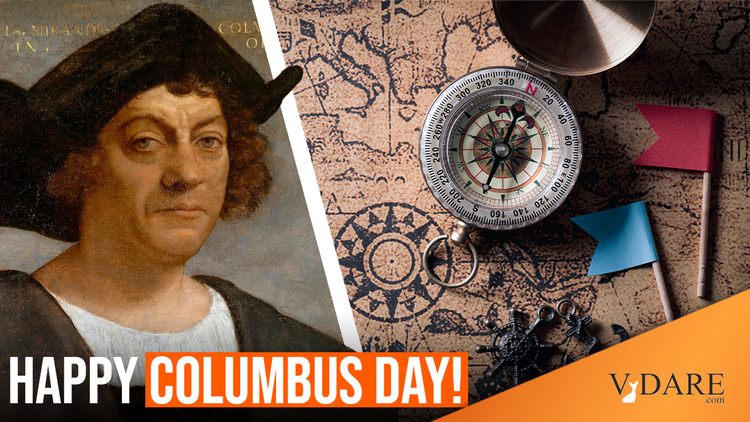


10/10/2004
Previously by David Yeagley: An American Indian View of Immigration
According to the Smithsonian National Museum of the American Indian, Christopher Columbus was an Indian.
The surreal global racist definition of the Museum is that all "indigenous" peoples of the Americas, including Pacific Islanders, are properly called "American Indian."
Given that Columbus thought he was simply on the different side of the same one-continent world, clearly he was as indigenous as any other human being — at least in his mind.
After all, he didn’t know where he was, and he had no way of knowing the shores he landed on weren’t connected to the Euro-Afro-Asian continent.
The cartography of his day simply did not portray the Americas. The world maps of Vesconte (ca. 1321), Bianco (1436), Catalan-Este (ca.1450), and Leardo (1452), clearly show the world as one huge land mass with variously contorted configurations and some islands. Columbus simply did not know of the continents later called the Americas.
The Vinland Island, mapped by 13th century Vikings, represented what they thought was another island west of Greenland, and not much larger. That was all that had been mapped of the Americas.
Kirkpatrick Sale’s account of Columbus, The Conquest of Paradise (1991), makes no mention of any of these maps, but only of Martin Behaim’s "globe," the ball over which Benhaim pasted a parchment map of the world. And that was in 1492. (Benhaim, from Nürnburg, Germany, had been in Lisbon, Portugal, in the 1480’s.)
Portugal had sent at least eleven missions in to the Atlantic Ocean between 1431 and 1486; all in search of more fabled islands. Everyone knew that sailing west did not mean falling off the edge of the earth. (By the year 1000 AD Leif Ericsson had already built huts on the coast of North America, though thinking it just another island, like Greenland.)
It seems to me — as a Comanche Indian — that today’s politically-correct racialists are therefore obligated to consider Columbus an American Indian.
A more difficult identity problem today concerns the Asian Indians, the people of the Indus River.
In English, they were first called Hindu, after the Persian pronunciation (adaptation) of the Sanskrit, sindhu, meaning, "river." (The Indus River takes its name from the Sanskrit.)
India, invaded by Muslims from the west, was called Hindustan in the 12th century. A Hindu was also one who practiced the native religion of the river.
Today, of course, the word Hinduism is reserved for the religion of India and the people are called "Indian."
However, the first written use of the word "Indian" in English is in 1566, in John Alday’s translation of Boaystuau’s Theatrum mundi, in which he refers to "an Indian philosopher named Diphileus" — a Greek name, no less.
In Spanish, a Latin-based language, the Hindu people were referred to as Indios probably as early as the Tartar Relation, Father John’s account of Plano Carpini’s 13th century mission to the Mongols. In Latin, Fr. John uses the word "Indos," (plural of Indian).
In any event, Columbus referred to the people he met on San Salvador as "Indians." Ever after in the history of the European development of the Americas, the indigenous peoples were called Indians. Spanish law always referred to them as Indians, as did English law.
Certainly, in American law from the Declaration of Independence through the Constitution, the indigenous peoples within the scope of the American colonies are referred to as Indians.
The first treaty of the United States federal government with an indigenous group was with the Delaware Indians in 1778. (Fort Pitt, Pennsylvania)
"American Indian" is the legal term for the indigenous peoples with whom the United States government had to relate. This is historical and unalterable.
However, the presence of Hindus (Asian Indians) in America is causing great confusion today. With two million, their population is roughly the same as the American Indian. They call themselves "Indian" and sometimes "Indian-American."
American Indians must not concede. The Hindus cannot have our legal, historical name here in America.
To the honor of the "indigenous" Columbus, on this his day, let Asian Indians be called Hindus and the indigenous people of the United States be called American Indians.
Columbus' maps clarified the world. The least we can do is preserve our clear language — if only in American English.
Dr. David A. Yeagley is an enrolled member of the Comanche Nation, Elgin, Oklahoma. His articles appear in TheAmericanEnterprise.com, FrontPageMagazine.com, and on his own Web site BadEagle.com, and he is a regular speaker for Young America’s Foundation. David Yeagley’s columns for VDARE.com include An American Indian View of Immigration, and To Deport or not to Deport. David Yeagley is the author of Bad Eagle: The Rantings of a Conservative Comanche.